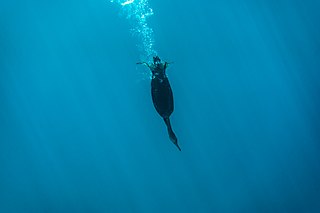
A kayak is a small, narrow human-powered watercraft typically propelled by means of a long, double-bladed paddle. The word kayak originates from the Greenlandic word qajaq.

Kayaking is the use of a kayak for moving over water. It is distinguished from canoeing by the sitting position of the paddler and the number of blades on the paddle. A kayak is a low-to-the-water, canoe-like boat in which the paddler sits facing forward, legs in front, using a double-bladed paddle to pull front-to-back on one side and then the other in rotation. Most kayaks have closed decks, although sit-on-top and inflatable kayaks are growing in popularity as well.

Trolling is a method of fishing where one or more fishing lines, baited with lures or bait fish, are drawn through the water. This may be behind a moving boat, or by slowly winding the line in when fishing from a static position, or even sweeping the line from side-to-side, e.g. when fishing from a jetty. Trolling is used to catch pelagic fish such as salmon, mackerel and kingfish.

Fly fishing is an angling technique that uses an ultralight-weight lure called an artificial fly, which typically mimics small invertebrates such as flying and aquatic insects to attract and catch fish. Because the mass of the fly lure is insufficient to overcome air resistance, it cannot be launched far using conventional gears and techniques, so specialized tackles are used instead and the casting techniques are significantly different from other forms of angling. It is also very common for the angler to wear waders, carry a hand net, and stand in the water when fishing.

A sea kayak or touring kayak is a kayak used for the sport of paddling on open waters of lakes, bays, and oceans. Sea kayaks are seaworthy small boats with a covered deck and the ability to incorporate a spray deck. They trade off the manoeuvrability of whitewater kayaks for higher cruising speed, cargo capacity, ease of straight-line paddling (tracking), and comfort for long journeys.

Swimfins, swim fins, diving fins, or flippers are finlike accessories worn on the feet, legs or hands and made from rubber, plastic, carbon fiber or combinations of these materials, to aid movement through the water in water sports activities such as swimming, bodyboarding, bodysurfing, float-tube fishing, kneeboarding, riverboarding, scuba diving, snorkeling, spearfishing, underwater hockey, underwater rugby and various other types of underwater diving.

An inflatable boat is a lightweight boat constructed with its sides and bow made of flexible tubes containing pressurised gas. For smaller boats, the floor and hull are often flexible, while for boats longer than 3 metres (9.8 ft), the floor typically consists of three to five rigid plywood or aluminium sheets fixed between the tubes, but not joined rigidly together. Often the transom is rigid, providing a location and structure for mounting an outboard motor.

Recreational fishing, also called sport fishing or game fishing, is fishing for leisure, exercise or competition. It can be contrasted with commercial fishing, which is professional fishing for profit; or subsistence fishing, which is fishing for survival and livelihood.

Canoe diving and Kayak diving are recreational diving where the divers paddle to a diving site in a canoe or kayak carrying all their gear in or on the boat to the place they want to dive. Canoe or kayak diving gives the diver independence from dive boat operators, while allowing dives at sites which are too far to comfortably swim, but are sufficiently sheltered.

Kayak fishing is fishing from a kayak. The kayak has long been a means of transportation and a means of accessing fishing grounds. Kayak fishing has gained popularity in recent times.

Fishing techniques are methods for catching fish. The term may also be applied to methods for catching other aquatic animals such as molluscs and edible marine invertebrates.

A pontoon boat is a flattish boat that relies on floats to remain buoyant. These pontoons contain much reserve buoyancy and allow designers to create large deck plans fitted with a variety of accommodations including expansive lounge areas, stand-up bars, and sun pads. Better tube designs have allowed builders to put ever-increasing amounts of horsepower on the stern. Pontoon boat drafts may be as shallow as eight inches, which reduces risk of running aground and underwater damage, this allows it to come close to shore to pick up and drop off loads.
The following outline is provided as an overview of and topical guide to fishing:

Standup paddleboarding (SUP) is a water sport born from surfing with modern roots in Hawaii. Standup paddleboarders stand on boards that are floating on the water and use a paddle to propel themselves through the water. The sport was documented in a 2013 report that identified it as the outdoor sporting activity with the most first-time participants in the United States that year. Variations include flat water paddling, racing, surfing, whitewater SUP, yoga, and fishing.

Aquatic locomotion or swimming is biologically propelled motion through a liquid medium. The simplest propulsive systems are composed of cilia and flagella. Swimming has evolved a number of times in a range of organisms including arthropods, fish, molluscs, amphibians, reptiles, birds, and mammals.

Certain species of fish and birds are able to locomote in both air and water, two fluid media with very different properties. A fluid is a particular phase of matter that deforms under shear stresses and includes any type of liquid or gas. Because fluids are easily deformable and move in response to applied forces, efficiently locomoting in a fluid medium presents unique challenges. Specific morphological characteristics are therefore required in animal species that primarily depend on fluidic locomotion. Because the properties of air and water are so different, swimming and flying have very disparate morphological requirements. As a result, despite the large diversity of animals that are capable of flight or swimming, only a limited number of these species have mastered the ability to both fly and swim. These species demonstrate distinct morphological and behavioral tradeoffs associated with transitioning from air to water and water to air.

Human-powered watercraft are watercraft propelled only by human power, instead of being propelled by wind power or an engine.

A tube fly is a general tying style of artificial fly used by fly anglers. Tube flies differ from traditional artificial flies as they are tied on small diameter tubes, not hooks. Tube flies were originated in Aberdeen, Scotland by fly-dresser Minnie Morawski for Atlantic salmon anglers around 1945. Tube flies were designed to improve hooking success and to prevent damage to complex and expensive salmon flies by the teeth of hooked salmon. Tube flies have been widely adapted to fly patterns for a variety of cold water and warm water species and are extremely popular for steelhead and salmon in the Pacific Northwest and northeast United States, as well as saltwater species along the Atlantic, Florida and Gulf Coasts. They are widely used in European waters for Atlantic salmon, sea trout and pike.





















